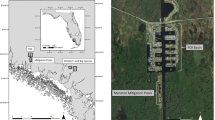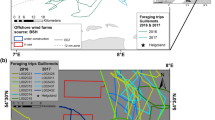Abstract
In field studies of a species’ population size, the movement and distribution of the target organism beyond the study area affect the population size estimate. Estimates are derived based on the number of animals caught, and catch efficiency changes with distribution and locomotion of the animals. This study, using acoustic telemetry and unmanned aerial vehicle (UAV) mapping, revealed that the Ezo abalone, Haliotis discus hannai, alters its distance moved depending on its distance from brown kelp. In addition, we reproduced abalone locomotion and brown kelp phenology as individual-based models. In the model, abalone moved to deeper water during the spring/summer brown kelp growing season, while during autumn/winter, the model showed them moving to shallower water and aggregating around the remaining brown kelp. The timing of moving to shallower area in the model coincided with the fishing season. Fishers mainly catch abalone in shallower areas. Therefore, it is possible that fishing efficiency will not decline later in the fishing season because fishers can catch the abalone immigrating to the main fishing grounds and those aggregating around the brown kelp. Our model indicated the need for improvement in the DeLury method and the catch per unit effort (CPUE) trends used in the abalone fishing industry.





Similar content being viewed by others
References
Bartumeus F, Da Luz MGE, Viswanathan GM, Catalan J (2005) Animal search strategies: a quantitative random-walk analysis. Ecology 86:3078–3087. https://doi.org/10.1890/04-1806
Bell MC, Elson JM, Addison JT (2005) The effects of spatial targeting of fishing effort on the distribution of the Norway lobster, Nephrops norvegicus, on the Farn deeps grounds, northeast England. New Zeal J Mar Freshw Res 39:1023–1037. https://doi.org/10.1080/00288330.2005.9517373
Coates JH, Hovel KA, Butler JL et al (2013) Movement and home range of pink abalone Haliotis corrugata: implications for restoration and population recovery. Mar Ecol Prog Ser 486:189–201. https://doi.org/10.3354/meps10365
DeLury DB (1947) On the estimation of biological populations. Biometrics 3:145–167. https://doi.org/10.2307/3001390
Fauchald P, Erikstad KE, Skarsfjord H (2000) Scale-dependent predator-prey interactions: the hierarchical spatial distribution of seabirds and prey. Ecology 81:773–783. https://doi.org/10.1890/0012-9658(2000)081[0773:SDPPIT]2.0.CO;2
Hammond JI, Luttbeg B, Sih A (2007) Predator and prey space use: dragonflies and tadpoles in an interactive game. Ecology 88:1525–1535. https://doi.org/10.1890/06-1236
Hayakawa J, Nakamoto K, Kodama M, Kawamura T (2021) Aggregation of adult abalone Haliotis discus hannai during the spawning season, and its associations with seasonal and interannual changes in the macroalgal community. Mar Ecol Prog Ser 670:105–120. https://doi.org/10.3354/meps13753
Kittle AM, Anderson M, Avgar T et al (2017) Landscape-level wolf space use is correlated with prey abundance, ease of mobility, and the distribution of prey habitat. Ecosphere 8:e01783. https://doi.org/10.1002/ecs2.1783
Matsumoto Y (2020) Effects of mucus trail following on the distance between individuals of opposite sex and its influence on the evolution of the trait in the Ezo abalone Haliotis discus hannai. PeerJ. https://doi.org/10.7717/peerj.8710
Officer R, Dixon CD, Gorfine H (2001) Movement and re-aggregation of the blacklip abalone, Haliotis rubra Leach, after fishing. J Shellfish Res 20:771–780
Ohmura T, Saido T, Musashi T et al (2015) Relationship between 1+ age juvenile and adult densities of ezo abalone Haliotis discus hannai, Iwate Prefecture. Japan Bull Iwate Pref Fish Tech 8:17–24 (in Japnase with English abstract)
Prince JD (1992) Using a spatial model to explore the dynamics of an exploited stock of the abalone Haliotis rubra. In: Shepherd SA, Tegner MJ, del Próo SAG (eds) Abalone of the world: biology, fisheries and culture. Blackwell, Oxford, pp 305–317
Shepherd SA (1973) Studies on southern Australian abalone (Genus Haliotis). i. ecology of five sympatric species. Mar Freshw Res 24:217–258. https://doi.org/10.1071/MF9730217
Shepherd SA (1986) Studies on southern Sustralian abalone (genus Haliotis) - VII. Aggregative behavior of H. laevigata in relation to spawning. Mar Biol 90:231–236. https://doi.org/10.1007/BF00569132
Shinohara Y (2019) Fisheries management of diving fishing for disk abalone Haliotis discus discus stock in Yoro, Miyazu city, Kyoto prefecture. Bull Kyoto Inst Ocean Fish Sci 41:13–18
Towner AV, Leos-Barajas V, Langrock R et al (2016) Sex-specific and individual preferences for hunting strategies in white sharks. Funct Ecol 30:1397–1407. https://doi.org/10.1111/1365-2435.12613
Turchin P (1991) Translating foraging movements in heterogeneous environments into the spatial distribution of foragers. Ecology 72:1253–1266. https://doi.org/10.2307/1941099
Uchida K, Kawamura G, Kasedou T et al (2010) Chemoreception in the abalone Haliotis discus hannai (Ino), and its role in inducing feeding. Nippon Suisan Gakkaishi 76:185–191. https://doi.org/10.2331/suisan.76.185 (in Japanese with English Abstract)
Werner I, Flothmann S, Burnell G (1995) Behaviour studies on the mobility of two species of abalone (Haliotis tuberculata and H. discus hannai) on sand: implications for reseeding programmes. Mar Freshw Res 46:681–688. https://doi.org/10.1071/MF9950681
Won NIL, Kawamura T, Takami H et al (2010) Ontogenetic changes in the feeding habits of the abalone Haliotis discus hannai: field verification by stable isotope analyses. Can J Fish Aquat Sci 67:347–356. https://doi.org/10.1139/F09-187
Woolford J (2019) World abalone fisheries and stock enhancement. Where in the world are we at? Is it worth it? Fisheries Research and Development Cooperation. Nuffield Australia Project 1702
Wyeth RC (2019) Olfactory navigation in aquatic gastropods. J Exp Biol. https://doi.org/10.1242/jeb.185843
Yamashita N, Hasegawa M (2005) Expanded DeLury’s method with variable effectiveness of fishing effort. Nippon Suisan Gakkaishi 71:775–781. https://doi.org/10.2331/suisan.71.775
Yatsuya K, Matsumoto Y, Sasaki K et al (2017) Phenology of the kelp Saccharina japonica and its effect on the gonad index of the sea urchin Mesocentrotus nudus across a depth gradient off the Sanriku coast, northeastern Japan. Fish Sci 83:1–8. https://doi.org/10.1007/s12562-017-1119-8
Young MA, Treml EA, Beher J et al (2020) Using species distribution models to assess the long-term impacts of changing oceanographic conditions on abalone density in south east Australia. Ecography 43(7):1052–1064. https://doi.org/10.1111/ecog.05181
Acknowledgements
Dr. Jun Hayakawa, Mr. Masaaki Hirano, Mr. Takanori Suzuki and Mr. Nobuhiko Iwama of Tokyo University helped us carry out the field research. Dr. Kousuke Yatsuya gave insightful comments and suggestions. We thank Ms. Fukumi Tashiro for her help in preparing for the field research. Mr. Yuichi Kohsaka, Mr. Ryoji Ushirokawa, Mr. Katsutoshi Sasaki and Mr. Nao Kimura from Omoe Fisheries Cooperative Association gathered data on their fishing activities. This work was supported by the JSPS KAKENHI (19K06217), Tohoku Ecosystem Associated Marine Sciences, Crest (JPMJCR13A5) and the Cooperative Program (No. 117, 2019) of Atmosphere and Ocean Research Institute, The University of Tokyo.
Funding
Japan Society for the Promotion of Science, 19K06217, Yukio Matsumoto, Core Research for Evolutional Science and Technology, JPMJCR13A5, Yukio Matsumoto.
Author information
Authors and Affiliations
Corresponding author
Additional information
Publisher’s Note
Springer Nature remains neutral with regard to jurisdictional claims in published maps and institutional affiliations.
Supplementary Information
Below is the link to the electronic supplementary material.
Rights and permissions
Springer Nature or its licensor holds exclusive rights to this article under a publishing agreement with the author(s) or other rightsholder(s); author self-archiving of the accepted manuscript version of this article is solely governed by the terms of such publishing agreement and applicable law.
About this article
Cite this article
Matsumoto, Y., Takami, H. The effect of brown kelp phenology on abalone locomotion and spatial distribution: acoustic telemetry and spatially explicit individual-based model approach. Fish Sci 88, 693–701 (2022). https://doi.org/10.1007/s12562-022-01640-y
Received:
Accepted:
Published:
Issue Date:
DOI: https://doi.org/10.1007/s12562-022-01640-y




